If you’re a Filipino or are familiar with food in the Philippines and you got asked “Why is Filipino food unique?”, what would you answer? Well, we don’t know about you but our answer would be that we have plenty of weird food names in the Philippines.
Well, maybe not exactly weird, more of funny. It’s a guarantee you’d find the names funny especially if you understand Tagalog or Filipino or if you have picked up some because you have lived in the Philippines for a long time.
But if you can’t, don’t worry – that’s what this article is for! We’ll take a look at nine of these names, explain why they’re funny in the Filipino context, and what kind of food they actually are.
And not to worry: they’re not ALL (some definitely are) bizarre food containing brain and liver or something like that. They’re also not some strange food combinations. In fact, once you get to know what they are, you might be itching to try one, two… or even all!
Let’s get to it, shall we?
Weird Food Name in the Philippines 1: Sundot Kulangot
If we’re talking about funny food names in the Philippines, this might be one that takes the cake. See, “kulangot” means “booger” in Filipino.
Who wants to eat booger? Definitely not any sane person!
But contrary to its name, it’s not one of those exotic Filipino dishes you may have heard of. Sundot kulangot is basically a snack or dessert that hails from Baguio. It is composed of glutinous rice, coconut milk, and brown sugar.
The ingredients are mixed and placed in wooden orbs, held together by red paper. The wooden orbs are then placed between bamboo sticks that are tied together to form a sort of tube.
To eat this treat, you get one ball, cut it in half, and poke (“sundot”) your finger into the half, like you’re picking your nose. Sure, you can use a little spoon or a stick to poke into the half and eat the soft and sweet dessert, but it’s funnier thinking that you’re picking your nose and eating the booger you got, right?
Just like some of us used to do as kids – whether we admit it or not.
Weird Food Name in the Philippines 2: Betamax
If you grew up in the 70s, you’d know what a Betamax is. For those who were born much, MUCH later, let us explain.
A Betamax is a tape that contains a video. Think of it as the earlier version of VHS tapes, which is the video format that came before VCDs, DVDs, and BluRay discs. We’re pretty sure you know what the last three are, right?
With us so far? Good. Now, what does Betamax have to do with food?
Well, it’s simple. Betamax the Filipino street food looks like Betamax the tape. And that’s where the name came from.
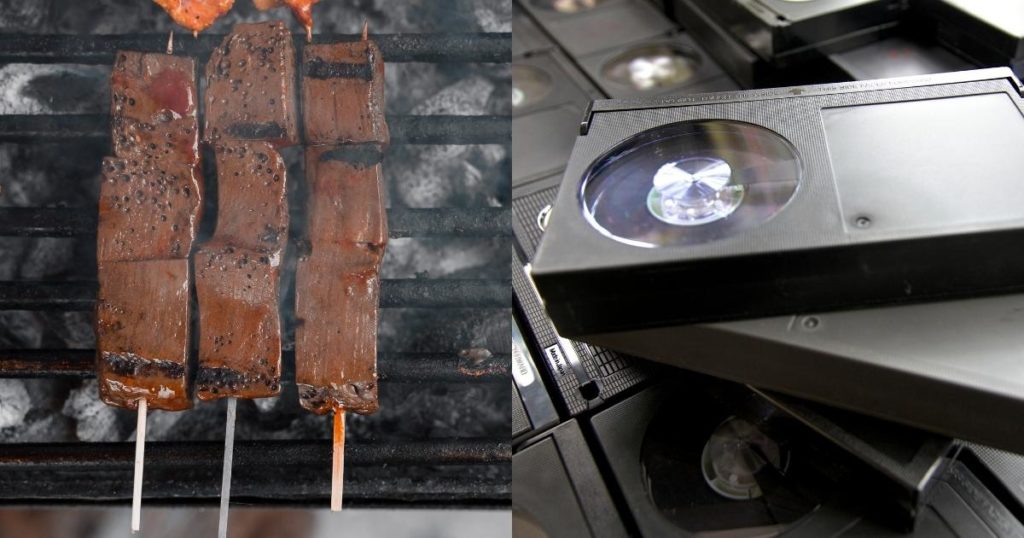
Right: Betamax video tape
See the resemblance?
And if you’re wondering what Betamax the food is, well, it’s a street food made from chicken blood or pork blood. People make this by extracting blood from the animal, which then cools down, gets thicker, and becomes gelatin-like. That’s how vendors cook it.
Wander around any Manila, Philippines city and you’ll find this popular street food being served especially during merienda time. Don’t knock it until you’ve tried it, especially once you’ve dipped this skewered food in vinegar with chilies.
You might end up getting this for drinking sessions, too!
Weird Food Name in the Philippines 3: Putok
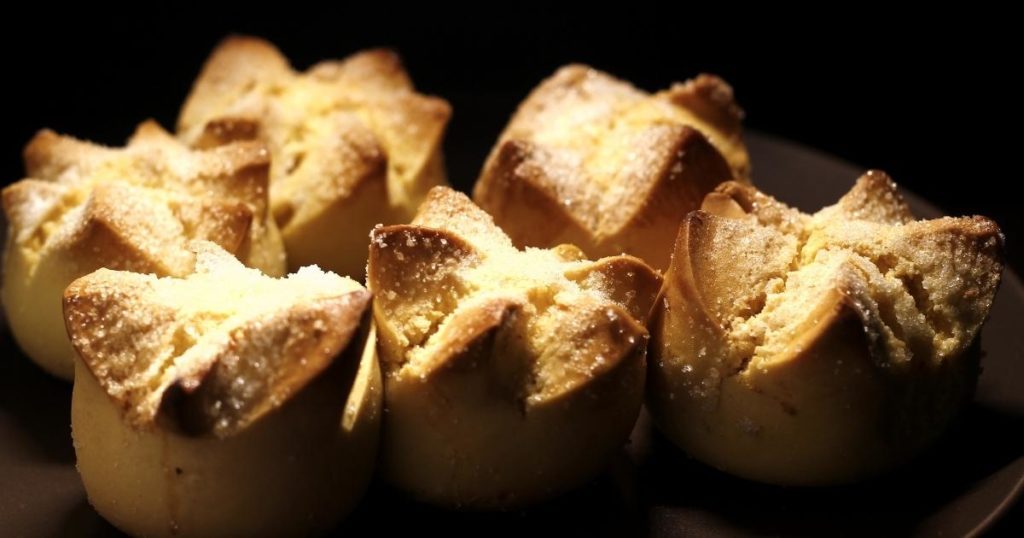
If you’re a regular blog reader, you’ve encountered this Pinoy bread before. Just to recap, Putok is not a weird food name – more of a funny one. You see, in the Filipino language, when someone says you’re “amoy putok,” it means you smell really bad.
Isn’t that such a nice visual imagery?
But don’t worry. The word “putok” can also mean explosion, as in volcano explosion. And that’s the more accurate translation for the description of this bread – check out the top part.
Looks like a volcano, right?
And when you take a bite, we promise that there will be nothing stinky. What you’ll get instead is a yummy, sugary soft or crunchy bread, depending on where you buy it.
And the white stuff on top? That’s sugar – not anything related to stopping body odor.
Weird Food Name in the Philippines 4: Adidas
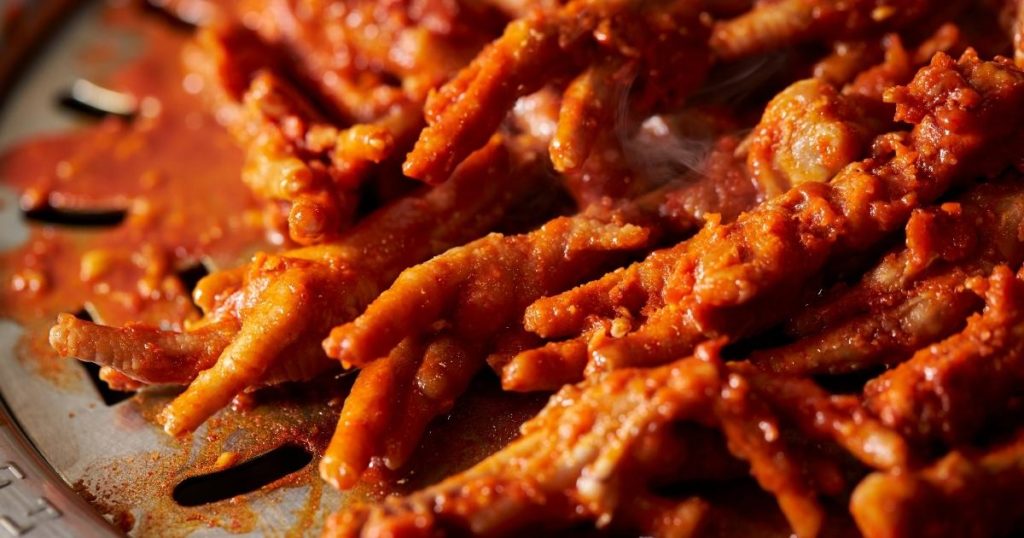
Would you say using chicken feet as a chicken dish is weird? Well, weird food or not, in the Philippines, the name is undoubtedly weird AND funny.
Yes, people call the chicken feet food “adidas.” As in a reference to the sports brand adidas. Why though?
Well, if you’ve seen the trefoil logo of the brand, you’d have to admit that this Pinoy food DOES look like the logo.

Plus, if you think about it, adidas is a brand commonly associated with footwear, right? So, you know… footwear, chicken feet… see the relationship?
Think about that next time you lace up your sneakers.
Weird Food Name in the Philippines 5: Pan de Regla
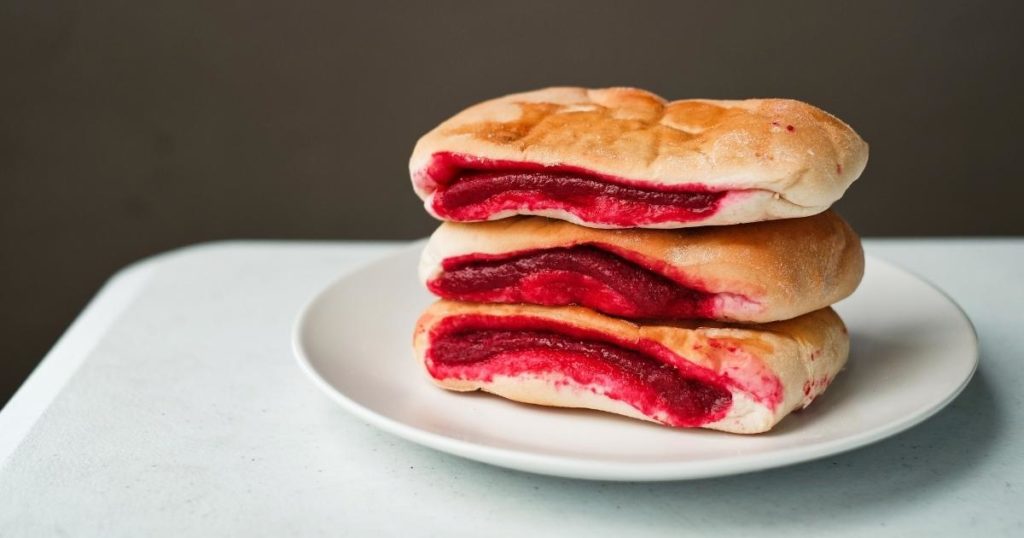
Of all the weird food names in the Philippines, this is probably the weirdest. Pan de Regla basically means “period bread”, as in the monthly visitor period. It’s in reference to the color red in the middle (although depending on who makes it, it can be a different color like purple or green).
Period bread doesn’t sound so appetizing, does it?
But if you were expecting some exotic food of the Philippine cuisine, well, we hate to burst your bubble, but it’s just bread made with some bright food coloring. It’s great for a snack or for breakfast, though, with its sweet taste and very soft texture.
It’s also called “kalihim” or secret bread, due to the fact that bakers use leftover bread to make this as the secret ingredient.
This bread also has a lot of weird food names aside from the two mentioned above, like:
- Innocent Kabukiran (We don’t think we want to know or explain this!)
- Balintawak
- Pan de Pula (literally red bread)
- Lipstick (obviously)
- Floor Wax bread (as in reference to the red Star Floor Wax)
- Ligaya (happiness – maybe because it looks like a very happy bread?)
- Alembong
- Bukirat (Again, nothing we want to explain!)
Weird Food Name in the Philippines 6: Lambingan Bread
“Lambing” is showing affection in Filipino. So how exactly is this bread related to affection? Does it give you affection or something?
Talk about weird food names in the Philippines.
If we had to make a guess, it’s because it’s a soft, cookie-like sandwich? And since the two sides are held together by butter, it’s like they’re showing affection to one another?
We also guess it’s probably why another name for this is Double Buddy.
Well, whatever the reason this got the name, the softness, the butter, and the desiccated coconut all over the sandwich will give you plenty of reason to eat one.
You probably won’t stop at one, either.
Weird Food Name in the Philippines 7: Kababayan
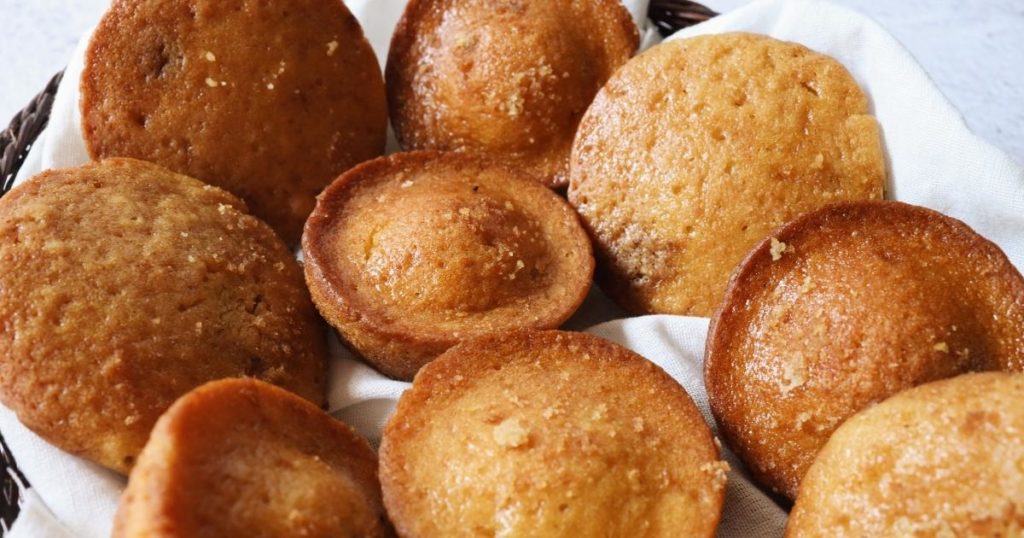
Like the Putok bread, you’ve encountered this before in our previous blog post. “Kababayan” means fellow countryman, but this is not one of those exotic Filipino dishes you might have heard about.
Yes, that means you won’t be committing cannibalism or eating any Filipino person. What you are eating instead is simply a sweet muffin made in the Philippines, despite the weird food name. The name is simply a reference to the hat (salakot) Filipinos used to wear before – exactly what the bread looks like.
Why they simply couldn’t have called it salakot bread, we don’t know. But what we do know is that we have a class to make kababayan bread – check it out!
Weird Food Name in the Philippines 8: Soup Number 5
Maybe we should have made this item number 5…
Sorry, we got lost a bit there. Anyway, what the heck is Soup Number 5?
Well, this is definitely one of the bizarre Filipino foods you were looking for in this list (if you were, at least). Did it being one of the weird food names in the Philippines give you a clue?
To answer your question, Soup Number 5 is an exotic Filipino soup. It is composed of the bull’s penis and the testes.
Talk about one of the dishes to challenge your taste buds, eh?
Apparently, Soup Number 5 is a favorite among Pinoys during drinking sessions. It’s also apparently great for curing hangovers as well as acting as an aphrodisiac – you know, getting the physical capabilities of a bull.
But why the name?
Well, according to Atlas Obscura, the popular story is that restaurants labeled this soup as a mystery soup. They would serve chicken, pork, beef, and seafood soups, but leave Soup Number 5 obscure. Whether it was a marketing tactic or it’s a way to not scare off customers, we’re guessing it worked, since people are still eating this exotic Filipino food.
Weird Food Name in the Philippines 9: German Chocolate Bread
Okay, so maybe “German Chocolate Bread” doesn’t exactly fit the “weird food names in the Philippines” category. But it’s still weird and funny. Why, you ask?
Well, it’s because of the name itself. As Chef Jimbo de Panadero mentioned in his live session with us, this bread was made by people from Visayas, so there’s nothing German about it.
Talk about weird Pinoy names.
If you called it by its other names like pan de choco or pan de chocolate, that would make more sense, right?
In any case, if you do have the opportunity, you should definitely try this soft, chocolatey bread – enjoy that crunchy streusel topping!
Want to try some delicious but weird Filipino-named food?
These are just some of the funny and weird Filipino food names. There are plenty more that we haven’t included in the list. And like we said about all the others on this list, these Filipino foods are very much worth trying – they’re pretty good!
Speaking of which, The Bailiwick Academy gives you the chance to not only try some of these weirdly-named foods… but to make them for yourself too! Check out our latest class with Chef Jimbo de Panadero: Panaderia Favorites 2!
Because you loved Panaderia Favorites 1, Chef Jimbo decided to make a part 2! In this latest class you’ll be making the following:
- Kalihim bread (otherwise known as Pan de Regla)
- German Chocolate Bread (which, again, are made by Filipinos)
- Double Buddy Bread (also known as Lambingan Bread); and
- Bonete, another hat-like bread like Kalihim, but all buttery!
We’re sure that making these bakery favorites will make you take plenty of trips down memory lane as you recall the simpler, good old days when you were just a kid, wouldn’t you agree? Plus, you’ll find yourself chuckling as you recall the names, making this class a doubly enjoyable experience.
Like with all our classes, you’ll get a detailed step-by-step instructional video and a support workbook. You’ll be able to recreate these classics easily in your very own kitchen. Enjoy them or add them to your food business menu.
Well, what are you waiting for? Sign up at The Bailiwick Academy today and start making these four delicious breads today!
—
Keep coming back to The Bailiwick Academy blog for more kitchen tips, tricks, and much more!


Pingback: What is a Dampa? - The Bailiwick Academy